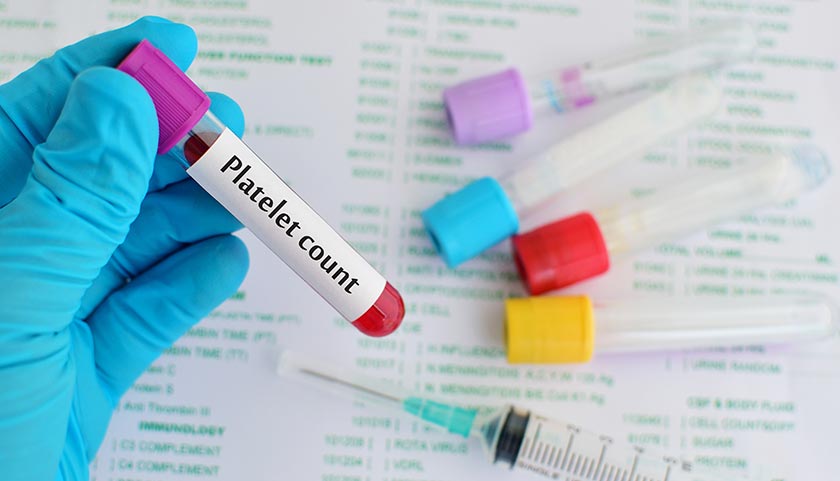There is a very small risk of developing a complex and rare clotting disorder associated with the use of AstraZeneca and the Johnson and Johnson vaccines for COVID-19. The outcome of this clotting disorder is the development of a cerebral venous sinus thrombosis, where venous drainage from the brain is blocked potentially leading to intracranial haemorrhage or haemorrhagic stroke. It has been labelled vaccine-induced prothrombotic immune thrombocytopenia (VIPIT).1
Similar to heparin disorder
VIPIT has been identified as similar to the rare clotting disorder caused by heparin therapy: heparin-induced thrombocytopenia (HIT). Typically, HIT appears four to 15 days after initiating heparin therapy, and a similar delay is seen in most cases associated with the vaccine.2, 3
In both syndromes, the sequence of events leading to clotting starts with platelet factor 4 (PF4). PF4 is a positively charged protein that is released into the circulation when platelets are activated. Platelets (thrombocytes) are fragments of cells without nuclei manufactured in the bone marrow. Once released into the circulation, they have a lifespan of about a week before being broken down in the liver.
Normally, platelets are early initiators of the clotting process. They clump together to form a “white clot” (without red blood cells) and release clotting factors that trigger the coagulation cascade and formation of a stable red clot.
Heparin is a negatively charged molecule and in some people, it binds to PF4 through electrostatic bonds. How vaccines bind to PF4 is not yet known. Both the AstraZeneca and the Johnson and Johnson (as well as the Russian-made vaccine) use an adenovirus vector for their delivery of the immunogenic component of the vaccine, and there is speculation the adenovirus component triggers VIPIT.3
When heparin binds to PF4, clumping occurs to form large complexes that trigger immune responses. Antibodies develop against the heparin-PF4 clumps, forming larger complexes which then attack circulating platelets.4 This triggers activation of the platelets, releasing further PF4, creating a positive feedback loop. Platelets are consumed at a high rate, causing thrombocytopenia.3
This overwhelming activation of platelets creates extensive white clots in the veins and widespread triggering of the coagulation cascade. HIT presents as a drop in platelet count (thrombocytopenia) with associated venous thromboses.5 In reported cases of VIPIT, cerebral venous thrombosis, splanchnic (abdominal, including liver) vein thrombosis, pulmonary embolism and other clots have been detected. Disseminated intravascular coagulation (DIC) has also been a feature, with subsequent consumption of clotting factors and increased risk of haemorrhage.3
In countries such as New Zealand, careful consideration of individual risk will be taken before decisions are made about the type of vaccine to administer.
There is still much to learn about this adverse effect associated with certain COVID-19 vaccines. In many countries where the impact of COVID-19 has been severe, the risk of VIPIT is far outweighed by the risks associated with the disease itself. In other countries such as New Zealand, if these vaccines are to be used, careful consideration of individual risk will be taken before decisions are made about the type of vaccine to administer.
References
- Dyer, O. (2021). COVID-19: EMA defends AstraZeneca vaccine as Germany and Canada halt roll outs. BMJ, 373, n883.
- Linkins, L. (2015). Heparin induced thrombocytopenia. BMJ, 350, g7566. doi.org/10.1136/bmj.g7566.
- Greinacher, A., Thiele, T., Warkentin, T., Weisser, K., Kyrle, P., & Eichinger, S. (2021). Thrombotic thrombocytopenia after ChAdOx1 nCov-19 vaccination. New England Journal of Medicine. doi:10.1056/NEJMoa2104840
- Nevrozova, T., Mordakhanova, E., Daminova, A., Ponomareva, A., Andrinova, I., Minh, G., Rauova, L., Litvinov, R., & Weisel, J. (2019). Platelet factor 4-containing immune complexes induce platelet activation followed by calpain-dependent platelet death. Cell Death Discovery, 5, 106.
- Arapelly, G. (2017). Heprain-induced thrombocytopenia. Blood, 129(21), 2864-2872.




